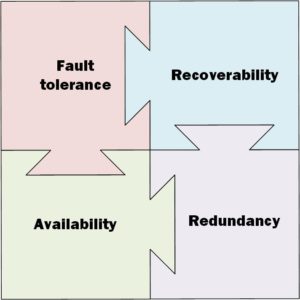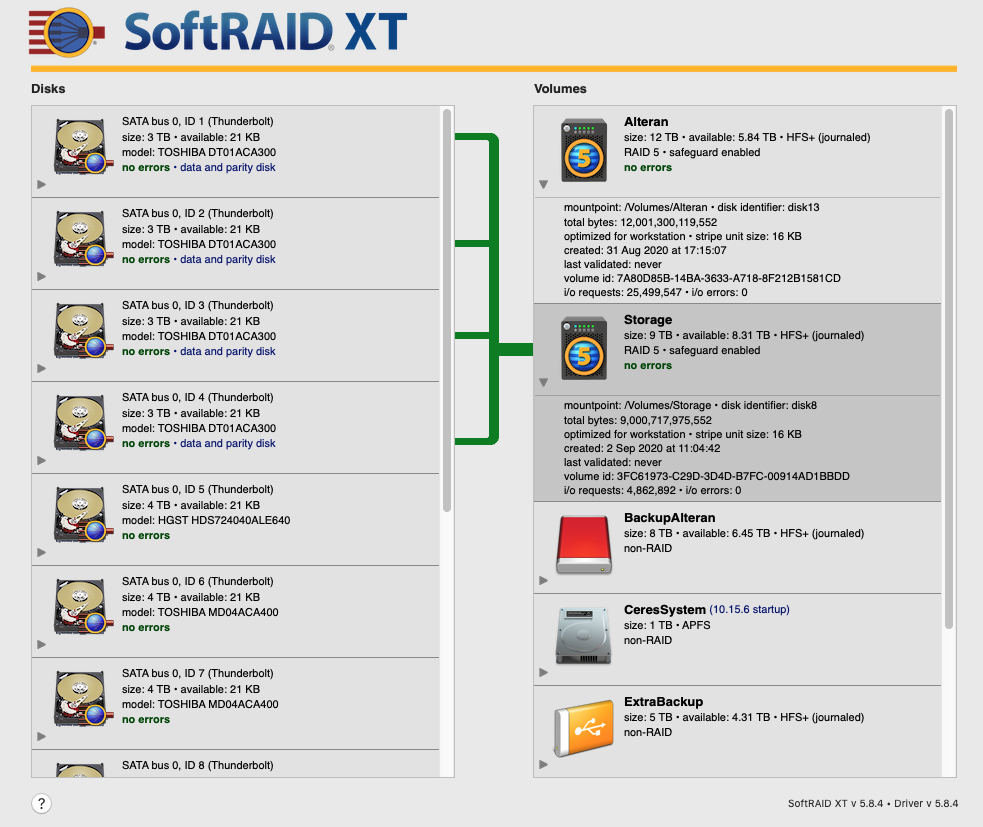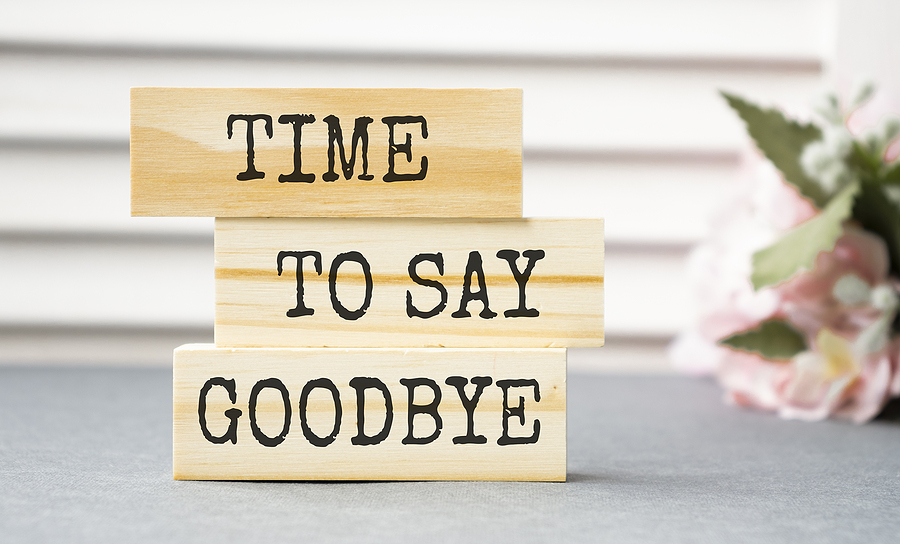The FARR model of data protection starts with fault tolerance – a fundamental requirement to provide a guarantee of data integrity and recoverability.

As a data protection professional, I tend to take data protection seriously even with my home equipment. A bit over seven years ago I caved and bought into the home-NAS game. In fact, after seven years of operation I finally replaced the first round of drives in my Synology 1513+ a while ago, since I was getting concerned with their age.
But I don’t only use NAS. Some things don’t play well with network-attached storage in the consumer market – take Apple’s iTunes/TV apps, for instance. iMovie, too. Aperture, back in its day. And don’t even get me started on just how utterly abysmal TimeMachine is when you try to work on a SparseVolume presented by a remote server. So for that local-access storage, I tended to use Drobo DAS units. Of these, I’ve had 3: a USB-2 4-drive model, a USB-3 5-drive model, and a USB-3 4-drive model.
And this week, I retired the two USB-3 systems. Good riddance.
You see, I’ve been having increasing stability issues on my macOS desktop at home – a reboot might complete successfully or fail on shutdown. OS upgrades were a nightmare of will-it-work-or-will-it-hang? Even standard OS patching would result in massive challenges where it might be fifteen minutes or more from the point of a startup chime before anything appeared on the screen. Honestly, it was like playing Russian Roulette.
I’ll admit, I blamed a lot on Catalina, which is perhaps the most unreliable operating system I’ve used since SunOS 5.4.
Because of all those challenges, I figured when I transitioned to a new desktop recently I’d ditch the existing user profile that I had been faithfully transferring from computer to computer since 2004. Everything went swimmingly until I was ready to transfer the Drobo storage across from the old system to the new.
Now admittedly, I had been getting a bit annoyed with Drobo. Despite Catalina warning on every reboot that Drobo’s software probably wouldn’t work with a future macOS, Drobo had seemingly been somewhat silent on the matter.
But when I installed the Drobo drivers on my new desktop and rebooted … everything fell apart. In fact, the system wouldn’t even come up. The system couldn’t be repaired; I literally had to boot into recovery mode and completely wipe the OS and start again.
Well gee, Drobo, thanks for that.
A month later and I’m finding that with the Drobo software removed, all those other problems have disappeared as well. Yes, I had to unexpectedly buy a new DAS storage system, but unlike Drobo, the software associated with it doesn’t cause system instability.
The only annoyance I have with the new solution is that OWC’s SoftRAID XT front-end interface has a terrifying quirk the first time you launch it where it’ll briefly report your storage is either offline, or in degraded mode, or both – until it connects to the back-end daemon and confirms the actual status. (Until I worked out what was going on, that left me with a few heart-flutters.) Oh, and the interface is a little … ugly:

That being said, I can put up with ugly if it works. (As Leonard Cohen once sang, We are ugly, but we have the music.)
Sure, macOS Catalina is still a steaming pile of happenstance and misadventure, but at least I can patch it again.
I knew Drobo had been acquired by StorCentric, but I hadn’t realised how poorly things seem to have become since the acquisition. Wikipedia’s Drobo article is positively scathing:
The company’s acquisition by StorCentric was announced in August, 2018. Most Drobo products have been Out of Stock since the beginning of 2020 with fans of Drobo wondering about the lack of communication addressing the shortage and the future of the company. The store on drobo.com still lists all Drobos as ‘sold out’ as of August 2020.
Wikipedia Article about Drobo, sourced 4 September 2020.
Drobo had a good story back in its day. BeyondRAID offered an interesting way of letting consumers or perhaps more correctly, prosumers, access RAID in a non-confronting way, and a way which allowed longer-term expansion. I did grow systems from 2TB drives to 4TB drives. But, BeyondRAID is hardly unique these days. Synology’s Hybrid RAID, for instance, delivers something similar, regardless of whether they take different approaches. I transitioned my 1513+ from 3TB to 6TB drives earlier in the year without a single outage and it’s now presenting over 23TB usable compared to the original >11TB usable I’d started with 7 years ago.
But it would seem that whatever StorCentric might have planned for Drobo, consumers aren’t part of the picture. They’ll want to hope they have more schtick than BeyondRAID – and no need for drivers.
And when Stage 4 lockdowns end in Melbourne, I’ll be taking two Drobos to the nearby recycling centre for scrapping.

Me Too, my system is completely screwed up and unfortunately I’m concerned I can’t get my data out of my drobo until they fix it with the thunderbolt issue and they have shown no effort to fix it
What is the Thunderbolt Issue you are talking about. I have 2 Drobo 5D’s and my thunderbolts began to fail on the logic board of my iMac (Late 2012). I’ve sent in the imac for repair, but I’m wondering if the DROBO is what caused the thunderbolt ports to fail on my imac.
BTW, I have been running Aperture with the thunderbolts for 6 years without a problem. I find that using the USB is slow and does cause some crashes and hangups of the Aperture program. I’m running Mohave. I need to keep it because of all my Aperture libraries.
Can you be more specific about this issue?
Thank you
Thanks for the information Drobo is not compatible with the Mac Bigsur also ?
I can’t say, I decommissioned my Drobos well before upgrading to Big Sur.
Out of interest, what are you using instead of Drobos?
For data I’m happy to have sitting on NAS, I’m using Synology. For direct attached data/storage, I’m using a Thunderbolt-3 8-drive OWC enclosure, with SoftRAID XT.
Thanks Preston, that’s most helpful.
I’m using my old Drobo Mini on my M1 MacBook Pro and Monterey.
Works just fine.
Me too but I’ve read mixed news that the dashboard may not be updated for Ventura (it needs to).
Drobo’s time has passed. You used to get a little more data with their RAID scheme. Drives are so cheap I’m going to pick up a Thunder Bay from OWC, put my 4x1TB drives into it. Create 2 RAID 1s and span ‘em. If I need more space, I’ll get some Seagate drives from Costco and Shuck ‘em.
My 5N2 died and of course, there are no Drobo corporate responses to the 5N2 issues. I need another 5N2 or something similar. Is there another server that will use the drives as formatted by the 5N2? I want to be able to simply insert the drives and be able to read the stored data from the 5N2, and have them work like they were in a 5N2 without any software issues. Any recommendations and guidance would be greatly appreciated !!!
If you don’t have backups to restore your data from, your best bet may be to trawl eBay to see if you can find another 5N2 Drobo so you can plug the drives into it. If you’re able to find a second hand 5N2 and transfer the drives in the same order, I believe it should spin up your RAID configuration. I hope you’re able to get your data back.
For anyone reading this and freaking out, FWIW, my DROBO 5D3 is working fine on my M1 Max MacBook Pro.
I did have to update the dashboard software to the latest, M1 compatible version, 3.6.1 released in early 2021. This required that I enable System Extensions to be installed – by default, the M1 Macs lock that down. I found this video helpful: https://www.youtube.com/watch?v=SL3FlgWQiS4
Once I did this and completed the dashboard install, my Drobo mounted properly. I also updated the firmware from the Drobo dashboard.
So far, no complaints.
One other point. I renewed my warranty in 2020 and My power supply failed in 2021. After going through a bit of a CSR gauntlet of 20 questions over several days, Drobo eventually sent me a new power supply.
I won’t pretend to know anything about the fiscal health or long-term viability of DROBO, but I will say, the reports of its demise seem to be exaggerated.
The SoftRaid driver on Apple Silicon is, also, problematic. An update in February/March 2022 fixed some of the worst problems, but the driver continues not to play nicely with my M1 MacBook Pro, despite disabling some security settings, and I have now unloaded the driver and abandoned the software.
My experience of drivers has often been negative, and I have concluded that drivers for critical storage are not worth the risk.
SoftRAID has certainly had a patchy time with the Apple Silicon platform for sure. I’ve also been unimpressed with their upgrade process — I’ve found each time on an Intel system that it prompts for reboot before critical permissions are established/granted. If you just blindly agree to the reboot before updating permissions in system preferences, access to the RAID devices after the reboot is compromised. While I’ve got that process documented now for myself, it leaves me reluctant to do upgrades of SoftRAID until I have plenty of spare time — just in case I have to back out.
I am using SoftRaid 6.2.1 and it is solid. I’ve got two OWC NVME ssd Raids managed by that and a QNap DAS. I am planning to back all that up to Backblaze B2 using ChonoSync 10.
Thanks for warning me off of Drobo. They say it’s CAVID that is leaving them out of stock. Even if that is true, how could one trust them for support? BeyondRAID is too proprietary anyway.
I am using a DN unit and went to the site when I upgraded to an M1 apple model. I also had to go thru the process of the extension in startup mode to change to accept the Drobo. Powered down and restarted and my Drobo is working just fine. This is on my Studio model. I can see the unit as before.
I’ve a Gen2 which has been pretty good until recently, didn’t realise there was a driver issue. I’m running it off an old iMac on High Sierra, so can still use the FW800 connection. I’ve more modern Macs but there’s an Apple problem with FW800 to TB2 adaptor, which Apple have never fixed & results in any external drives being disconnected after time. That stopped me connecting directly.
I’m hoping my Gen2 PSU has just died. Unfortunately, the drive was disconnected and left in a cupboard for 4 months (long story) and on reconnecting is cycling at start. Last time I had these symptoms it was a PSU problem.
My Drobo B810i died about a year ago…. How do i recover data…. Around 30tbs…
Any help will be highly appreciated.
If you have backups you can restore from, that would be your best starting point. If you don’t have backups, about the only options I could think of would be (a) to see if Drobo can send you a loaner unit to transfer your drives into then copy the data across, or (b) if you could buy a second hand unit on eBay.
hey any chance you didnt take the 5d3 to the scrape yard? I need to source a 5d3 to replace my dead 5d – so if i can find an enclosure it would save my life (at least my data).
happy to pay
This is all very helpful, thank you. My video team has 2 Drobo 5C’s. Only 3 of the 5 Seagate NAS drives are actually mounting and showing up on both of our Drobo’s. Any recommendations on how to actually get someone on the phone from Drobo tech support? I submitted 2 tickets have had not heard a thing.
After reading some of the blog post replies, I’m thinking we need to update our Drobo software and firmware. We purchased the Drobo’s in 2019 and have not done any software updates since. We were hoping our Drobo’s would alert us of new software updates…our experiences with these Drobo’s really has not been great – and with their lack of customer support, we won’t be purchasing any more.
Appreciate any advice and insight!